How children with Down Syndrome can develop good fine motor skills
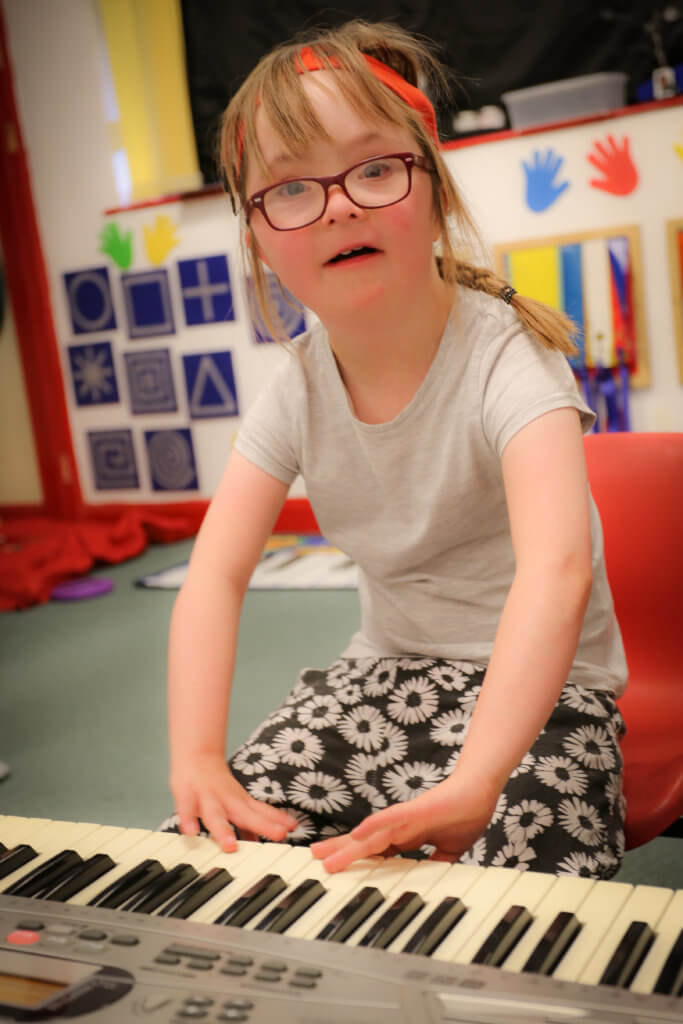

Help us #MakeItHappen!
10 Fine Motor Activities to try at Home
Music is a motivating way to improve fine motor skills, and there are lots of options depending on skill level.
Your child can just use their hand to hit a keyboard or a drum as an easy way to get some cause and effect without needing high levels of fine motor skill.
Move on to using an implement in their hand. A stick to hit the drum or a rattle/ tambourine in their hands can work well to practice grasping.
Next try to be a little more refined in their fine motor skills and just use the pointing finger free. Practice pressing a keyboard key with this finger, pressing buttons on musical toys or using the pointing finger for games on a tablet.
If you don’t have any instruments at home you can use every day object such as a wooden spoon and upside down saucepan, a plastic bottle with some rice in it as a rattle or silver foil/ fire blanket to scrunch. For other ideas, this blog post has some great ideas for making musical instruments from everyday objects in the home.
Lots of children enjoy sorting games. Start by organising larger toys – like cars or Duplo blocks – into different coloured piles.
Move onto sorting smaller items by type, shape or colour. Try different pasta shapes, paper clips, pens and pencils, lego bricks or coins.
If this works well try even smaller items. Mixing different dried foods can work well: for example mixing rice with lentils and dried beans or chick peas. This activity can be made more engaging by dyeing the food bright colours prior to play (see our messy play to find details of how to dye different foods).
To make this task more challenging, try offering a pair of tweezers to pick the items up – or suggest they use their less dominant hand.
Once your child has sorted their small objects, you can suggest an additional activity using the items they’ve sorted. For example, they could make a necklace out of the tube pasta, or make a picture using glue and the dried food items. This will keep your child motivated to keep sorting and is another great way to work their fine motor skills.
You could make this a little more challenging by creating a Laser Quest game in a box. See our video for details of how this can work.
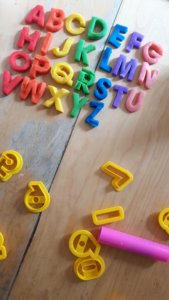 If you don’t have play-dough there are plenty of different ways to make dough at home. See our video for how to make the dough and how to play with it if you have less fine motor skills.
If you don’t have play-dough there are plenty of different ways to make dough at home. See our video for how to make the dough and how to play with it if you have less fine motor skills. - Make the dough with your child for an extra opportunity to strengthen hands and fingers.
- Kneading the dough, rolling it with a rolling pin, squashing dough balls, squeezing it through their fingers, pushing items into the dough – with a full hand or with a pointing finger are all great ways to work your child’s fine motor and hand skills.
- You can also put different objects into dough or other soft play mixtures – things they need to find or things to play with e.g. cars or plastic animals/ dinosaurs/ figurines.
- Hiding marbles in your play-dough will work their manipulation skills brilliantly.
Playing with stickers is a great way to practice fine motor skills.
Peeling stickers off their backing uses as much (if not more!) skill as sticking them down
You can sticking easier by peeling most of the sticker off its back. Your child can use their fingers to take the rest off and then stick to a piece of paper or part of their body.
Try using stickers to ‘colour in’ a shape – or draw a shape with the stickers. You could always give stickers as a reward for great effort or behaviour – they won’t even know they are still working!
- S
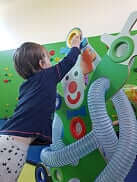 tart with putting soft toys or rolling large balls into an open container. Use brightly coloured containers such as a bright pink stain remover tub, or items with metal bases to give “noisy” feedback eg hot chocolate tub or Pringles tube. Tissue boxes also work well.
tart with putting soft toys or rolling large balls into an open container. Use brightly coloured containers such as a bright pink stain remover tub, or items with metal bases to give “noisy” feedback eg hot chocolate tub or Pringles tube. Tissue boxes also work well. - Progress to smaller toys into a smaller container. You could combine this with a matching game-putting the red objects into the red container etc
- Shape sorter games are fantastic for working fine motor skills. If you don’t have a shape sorter, cut a circular hole in the lid of a plastic pot and post small objects.
- As your child gets more accurate, cut smaller circles or slits and post smaller objects such as coins, pebbles or buttons. You could cut different sizes of slits for different sizes of objects so they have to work out sizes as they post.
- Use marble runs and car runs to motivate and interact with other people using posting skills. There are lots of ideas for home-made marble runs on Pinterest.
Building towers requires a steady hand and precision in placement of the next block.
Start with bigger objects to stack, such as cushions and pillows, books or empty cans.
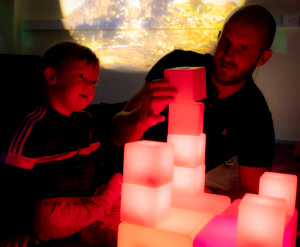
As they get more accurate, try smaller stacking such as coins, lego, or blocks. They can build all sorts of scenes and structures with building toys and piecing the pieces together is great for their fine motor skills.
If they get really good, try to challenge them to find things to stack – use flat pebbles, cars, or soft toys.
Another great thing with this game is that they get to knock it all down at the end!
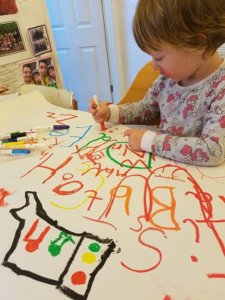 Start drawing with their fingers/ hands. This could be in sand, in shaving foam or in other messy play or on a tablet on games such as ‘Finger Paint’. (See our section on Fine Motor Apps for other ideas) To show them the way, you could draw a line for them to copy or follow in the path you have made in shaving foam or sand.
Start drawing with their fingers/ hands. This could be in sand, in shaving foam or in other messy play or on a tablet on games such as ‘Finger Paint’. (See our section on Fine Motor Apps for other ideas) To show them the way, you could draw a line for them to copy or follow in the path you have made in shaving foam or sand.- They could also use other objects to draw – for example using stickers, glue and glitter or glue and dried pasta.
- Move on to trying drawing with implements. Large pieces of chalk or crayons need less fine motor skills than smaller implements. To begin with any grip is fine as holding the grasp as well as keeping pressure can be a great challenge in itself.
- To begin with encourage any mark they can make on the page or on a chalk board. As they get better at this, encourage them to draw lines; up and down, side to side or diagonal. The most difficult movement is curved lines and eventually a circle.
- Start with freestyle and then try dot-to-dot games, complete the picture, colouring in and then copying simple drawings that you do for them.
- As your child improves, move on to thinner crayons or pens. Their fine motor skills will take time to develop so spend weeks or even months on each stage before trying another stage.
- Ideas for outdoors include painting the wall, floor or fence with a brush and water. Squirting with water pistols, plant spray bottles or squeezy bottles is great for strengthening hands and working on hand eye coordination.
Puzzles are lovely for making children match up shapes and work their fine motor skills. Some children will try to use force instead of turning the puzzle piece to make it fit so make sure you wake up their muscles first to help with this and start with easy puzzles where they can be more successful to teach them about turning the puzzle piece.
Puzzles with pegs on them are often the best place to start if children don’t have full fine motor control.
Put stickers on the bottom of the puzzle piece or in the hole the puzzle should go into to make the game more appealing.
Move onto regular flat puzzles as their skills improve.
Next, use smaller pieces as skills.
If you don’t have puzzles at home, find a pretty page from a magazine and cut it into a few pieces. Your child can piece the pieces back together.
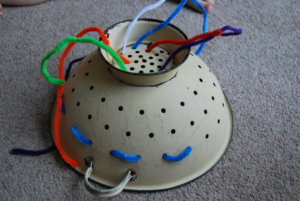 Start with pipe cleaner and a colander. Your child could make lines across to make a bridge for their cars. Or keep to the side of the colander and just go freestyle and make some lovely patterns.
Start with pipe cleaner and a colander. Your child could make lines across to make a bridge for their cars. Or keep to the side of the colander and just go freestyle and make some lovely patterns.You could also stick a piece of uncooked spaghetti in some play-dough or blue tack on the table so it is sticking right up. Your child could then thread tube pasta onto the spaghetti.
As their skills improve, use laces (with the taped end) to thread paper or card. Use a hole punch to make holes along the edge of a piece of card.
As they improve, use string, or ribbon or even some thread on a needle for threading games. They could add colour to a basket by adding ribbon through the holes, have fun re-lacing the shoes in your house or cut some straws into small tubes to lace into a necklace.
Using scissors is a great way to strengthen hands.
You can start by cutting dough as this teaches the right technique for cutting. Make a snake out of dough and ask then to cut it into pieces. Make sure their thumb stays upright when they cut.
Move on to cutting straight lines on card and/ or paper.
As their skills develop you can be inventive with your cutting and draw interesting shapes for them to cut. These activities should be supervised at all times.
See our video for a great demonstration of making chain Minecraft men with just straight line cutting.
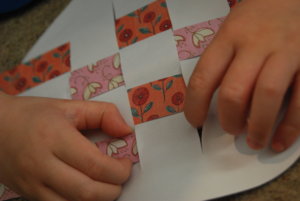 Start with simple paper weaving. Cut some coloured paper into 1 inch strips. Cut a different piece of paper into 1 inch slits but leave an inch uncut at the end so the paper is still attached at the top. Your child can then slip 1 loose strip over and under the main paper. Start nearest to the end which is still in one piece. The next piece goes over and under (the opposite from the first strip).
Start with simple paper weaving. Cut some coloured paper into 1 inch strips. Cut a different piece of paper into 1 inch slits but leave an inch uncut at the end so the paper is still attached at the top. Your child can then slip 1 loose strip over and under the main paper. Start nearest to the end which is still in one piece. The next piece goes over and under (the opposite from the first strip).You could try this with smaller strips of paper to make it more difficult.
Move on to weaving knitting wool. This video shows how you can weave just using a piece of cardboard.
4. Move onto shapes. This video shows how to make cool patterns on a paper plate but you could use any cardboard you have (old cereal boxes etc) instead. You could even write out your child’s name.
https://youtu.be/ZhAqPwx97jo
5. Here is a lovely video which shows how to make a simple Pom Pom. This is a lovely exercise to use repetitive movements with your child’s hands to strengthen and improve their endurance.
6. Knitting is a great progression to weaving and brilliant for developing those more advanced fine motor skills. Finger knitting is straight forward and a good way to start and you only need some wool to try it. This video gives a lovely demonstration.
This website has some wonderful ideas for different fine motor activities to work specific fine motor skills.





